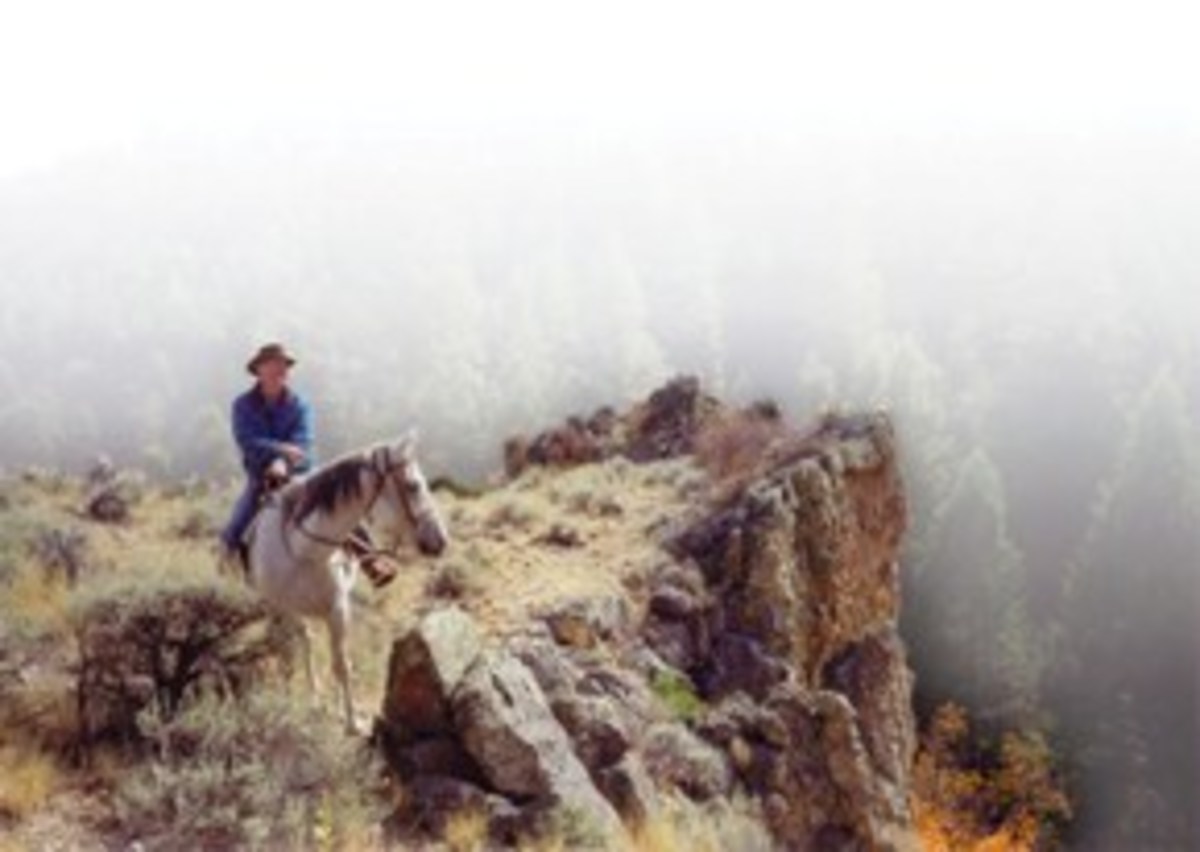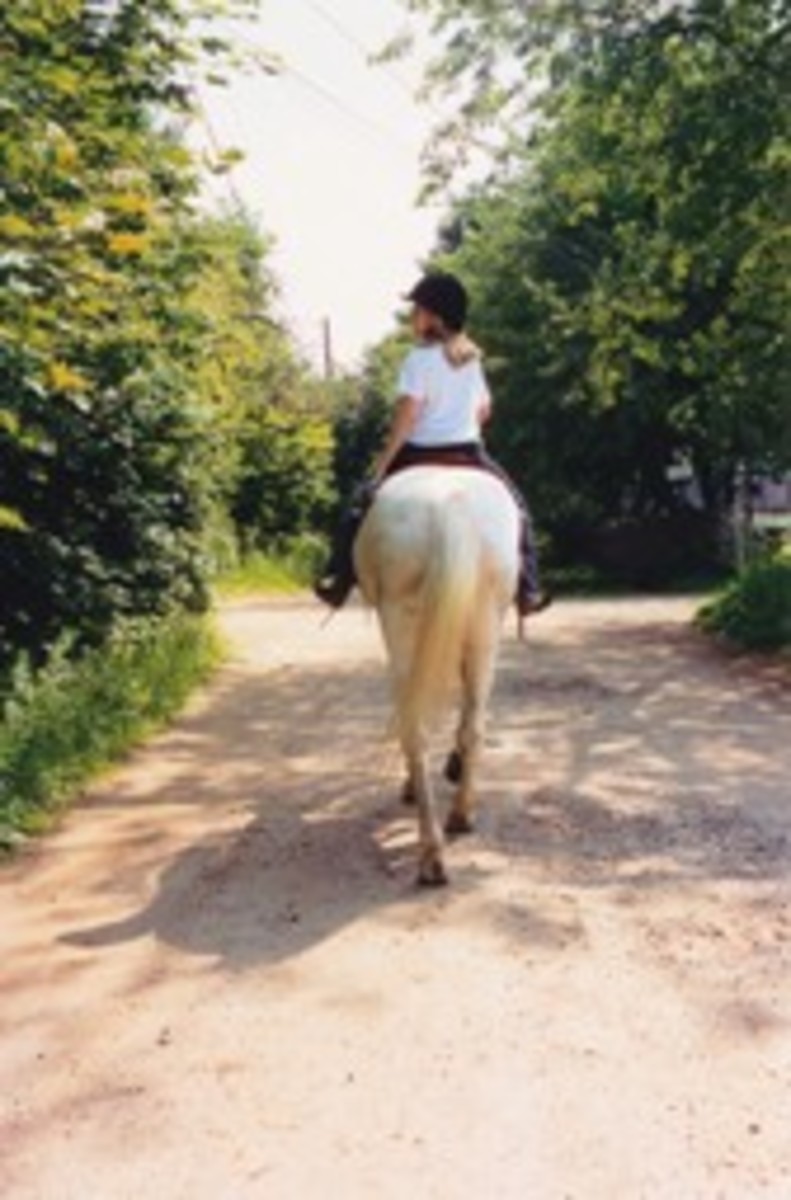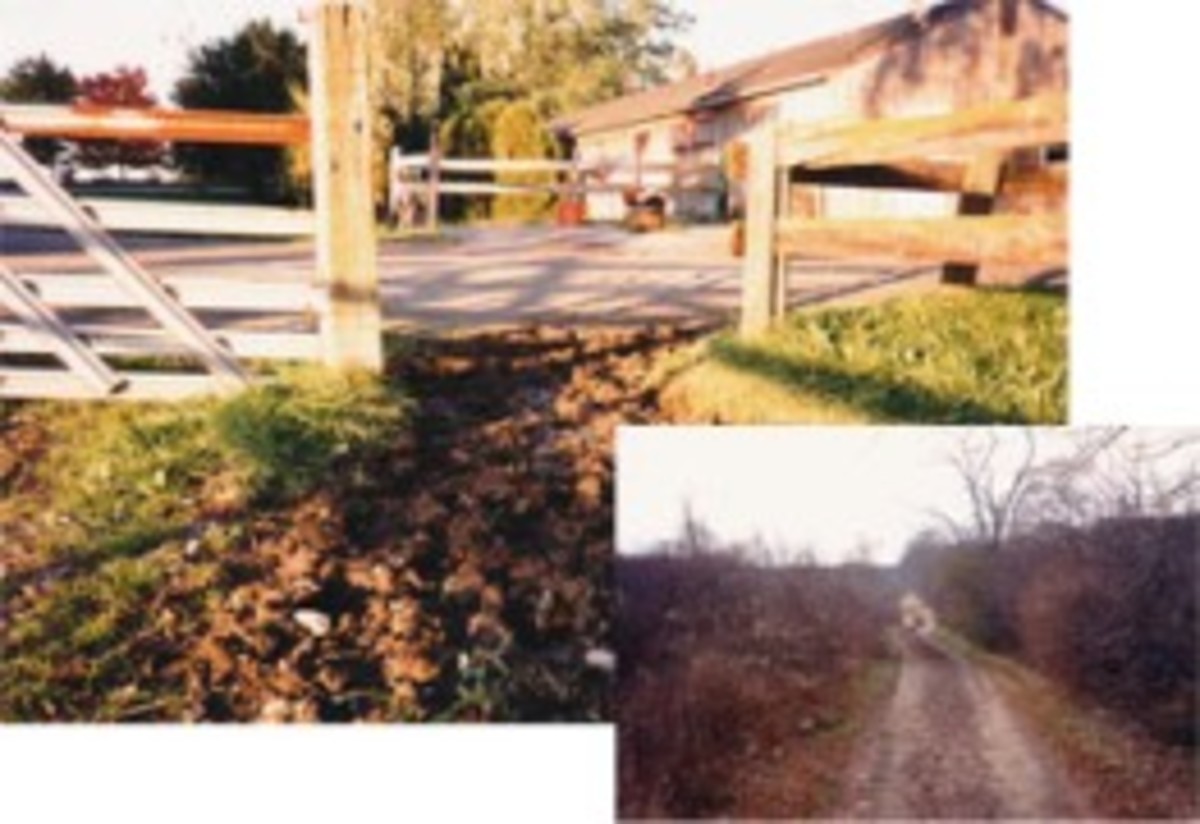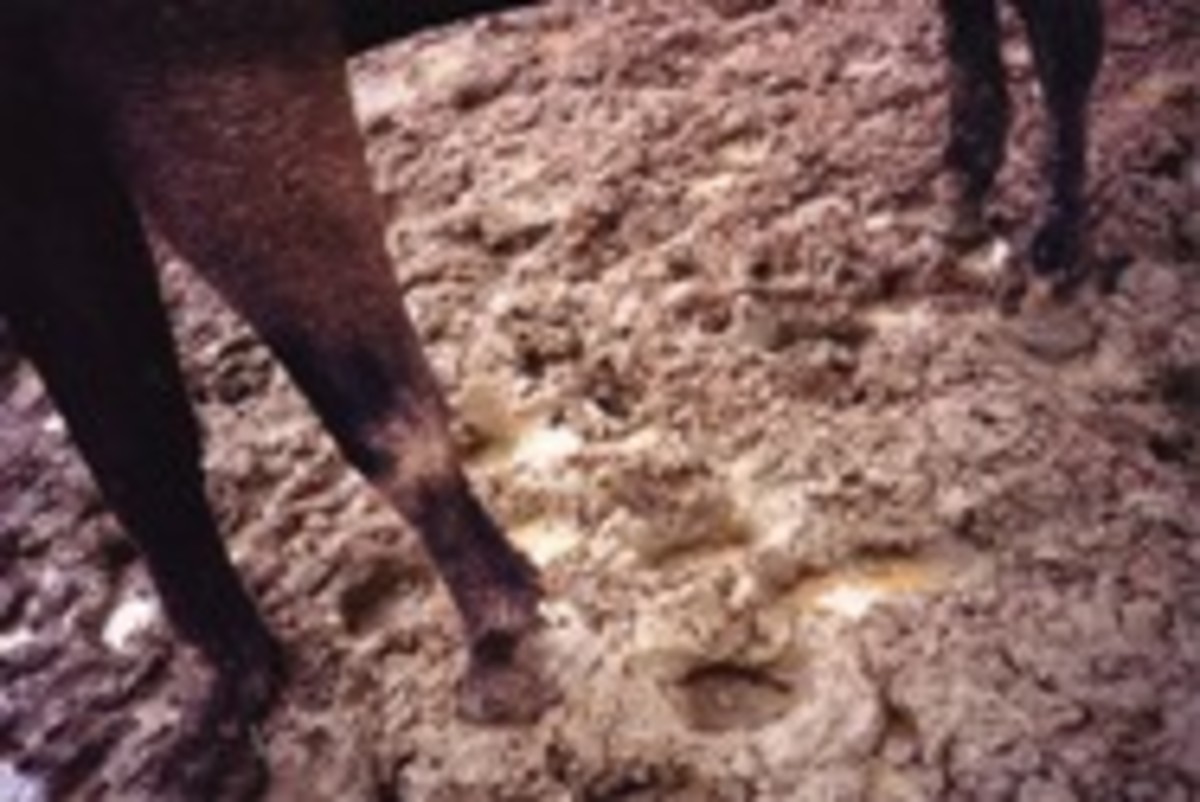
Our family has been ranching in the mountains near Salmon, Idaho, since 1955. We’ve put lots of miles on lots of horses over the years, horseback riding range all summer and moving cattle in rough country. During the 1970s and 1980s, we did some competitive distance horseback riding.
Horseback riding on the range and on the trail taught us a great deal about keeping horses sound under all kinds of conditions. Trail horses occasionally suffer foot and leg injuries, directly or indirectly related to poor footing. You can head off some problems by being prepared. Know what kind of footing you’ll be dealing with, know your horse, condition him for the various situations you might encounter, and be cautious in tricky terrain. Slow down, and don’t take chances.
Here, I’ll discuss five different types of footing: Hard ground, rough terrain, sand, mud, and snow/ice. I’ll tell you the potential problems each type of footing can create, how such problems can happen, and what you can do to head off an injury.

Hard Ground
Potential problem:Concussion to bones and joints.
How it can happen: Concussion on hard ground can take a toll on joints, but most often the concussion problems are in the feet. Young horses are particularly susceptible to jarring and hard pounding, because their joints and bones haven’t yet matured. Your mature horse might suffer sore joints the day after traveling over hard ground, but generally it’s only temporary. However, as your horse ages and his joints stiffen, hard ground might make him continually sore, especially if he has a degenerative joint or bone condition, such as arthritis.
Potential problems:Heel soreness; sole bruises; road founder.
How they can happen: If your horse is at all sore in the heels (which many horses are, due to the way they’re built or the way they’re shod), you’ll see heel soreness first after traveling on hard ground. The foot naturally lands heel first. The heel area, with its extra cushioning, is better designed to absorb concussion than the toe area. However, your horse’s heels will become sore first if you travel through rocks and hard ground all day. Pounding over hard ground can also lead to bruising on the soles of your horse’s feet and road founder (inflammation of the laminae – the sensitive membrane layers in the hoof).

What you can do:
- Find softer ground. If you can pick your trail, find softer footing, such as the road shoulder instead of the pavement or hard-packed dirt track. Good earth footing is best, with enough “give” so the foot or shoe can sink in a little.
- Wait until your horse matures. Avoid riding your trail horse on hard ground until he’s at least 4 years old. When he’s 2 or 3 years old, he’ll be more prone to stress-related problems, because his bones and joints aren’t completely mature, thus vulnerable to injury. Even walking and trotting on the trail can lead to injury; avoid trail riding him until he’s at least 4 years old.
- Consider special shoeing. Your farrier can shoe your horse with pads, which can help minimize concussive pressures that might aggravate arthritic and bony problems. Pads can also help with sole bruising. Some riders use plastic shoes to minimize concussion, but these don’t work for all horses. Work with your farrier to find a pad or shoe that works best for your horse.
- Consider a joint supplement. Talk to your veterinarian about supplementing your horse’s diet with glucosamine and chondroitin sulfate. Such products seem to help relieve some joint problems.

Rough Terrain
Potential problems:Pulled muscles; muscle cramps; strained joints; fatigue.How they can happen: Your horse carries about 60 percent of his weight on his front legs. This weight load changes when you ride him up and down hills; his front feet will take more weight than his rear feet, especially going downhill. When going uphill, your horse’s hindquarters work harder than usual as he pushes himself upward. When the footing is less than ideal, such added stress can cause pulled muscles, muscle cramps, strained joints, and fatigue.
Potential problems:Sprains; heel bruising; stone bruise.
How they can happen: A trail with ruts, rocks, or uneven surface due to erosion can make a foot land at odd angles, which can lead to a sprain. Such terrain can also increase risk of heel-bulb injury and bruising. And, if hard matter lodges between the frog and hoof wall, it can create a painful stone bruise.
What you can do:
- Condition your horse. The best way to prevent an injury in rough, hilly terrain is to have a fit horse. If you live in flat country and need to prepare for a mountainous ride, find a way to simulate hills – such as going up and down a highway overpass.
- Go slow. Slow down when traveling through rocky, hilly terrain. Walk rather than trot, and don’t push your horse to his fastest walk or traveling gait.
- Dismount. In especially rough, hilly terrain, take a tip from endurance riders. Get off your horse, and run alongside him to help minimize muscle stress and fatigue.
- Check for rocks. Carry a hoof pick, and periodically check your horse’s hooves for rocks, stones, and other trail debris.
Travel Tip
When you take your horse on a trail ride in a unfamiliar region, expect variables in terrain and footing. Sand in southern New Mexico might be an inch deep, whereas Sand in southern Carolina might be 2 and 1/2 inches deep. This can make a big difference to your horse. Ask riders in the area what the footing is like, so you’ll know what to expect. Then pay attention to the ride’s effects on your horse. If something doesn’t seem right, turn around, and head back home. If a problem persists, call your veterinarian.
Sand
Potential problem: Tendon/ligament injury.
How it can happen: Believe it or not, trail horses tend to suffer more leg injuries from soft ground than hard ground. In sandy or boggy footing, the extra stress put onto your horse’s legs can result in superficial flexor tendon and suspensory ligament injuries. Superficial flexor tendons run down the back of the foreleg, between the knee and foot. In the hind leg, they run between the hock and the foot; they cause your horse’s joints to flex when stimulated. Suspensory ligaments run behind the cannon bone over the fetlock joint to the pastern bones; they support the fetlock joint, which is your horse’s ankle.
The biggest culprit is fatigue. Soft footing can tire your horse sooner than you’re used to and to a much greater degree than you might imagine, simply from the extra work he must expend to get through it. His joints must flex more and his legs must move more distance at every stride. More flexing means more pull on tendons and ligaments, because the foot didn’t stop soon enough; it keeps slipping a little on every stride. This wasted motion with every step leads to fatigue – and fatigue leads to tendon and ligament injuries. Note that such injuries don’t always occur near the end of a long ride; your horse can go lame at any point if he’s not in condition.

Potential problem: Pulled/strained hindquarter muscles.
How it can happen: In soft footing, your horse can also suffer pulled or strained hindquarter muscles, especially if you climb hills. When you ride on hills in soft footing, his muscles have to work extra hard, because he lacks traction. His foot will tend to slip at every step, adding more work to a leg already under stress. Unless you’ve conditioned your horse on hills, his muscles aren’t in shape to handle that kind of load.
Unfortunately, you might not notice such problems soon enough to prevent them. You might remember later that your horse seemed to be sweating more or working harder than usual, but you didn’t relate that to the strained muscles or hind-leg weariness at the end of your ride.
What you can do:
- Condition your horse. The best way to prevent sand-related injuries is to have a fit horse. Slowly accustom your horse to soft footing by walking at first, and slowly working up to the faster gaits.
- Watch your horse. See how he’s handling trail conditions in regard to his fitness level. If you notice that he seems to be working harder than you’d expect, it’s probably because of the footing.
- Watch other riders. If you’ve conditioned your horse on firm footing, then go on rides in soft footing – such as in the desert or on the beach – watch the other riders. If their horses seem to be sinking deeper than normal, chances are, your horse is, too.
- Take it slow. It’s the combination of speed and soft footing that will tend to cause problems for your horse; you won’t see as many injuries when you take it slowly. Slow down so your horse doesn’t become overly fatigued.
- Take rest breaks. Frequent breaks will help your horse’s muscles accommodate the extra work load and will help battle muscle fatigue.
- Shorten your ride. Your horse might not be ready for a long ride on soft footing, even if you go slowly and take frequent breaks. If your horse isn’t conditioned on soft footing, plan short rides.

Mud
Potential problems:Muscles sprains, strains, and soreness.
How they can happen: Muddy conditions can create a lot of problems, especially since you probably haven’t conditioned your horse to this type of footing. He’s likely not used to making his way through mud. Even if his corral or paddock is a muddy quagmire, he’s not used to the added stress of carrying a rider while slogging through deep mud, and/or slipping and sliding in slick, wet footing. The increased level of work and slipping can put your horse at risk for mild sprains, strains, and soreness.
Mud also creates a vacuum effect. Your horse must expend extra effort to pull his feet from the mud. To do so, he’ll use different muscles than usual or use the same muscles more strongly. This exertion can also lead to sprains, strains, and soreness.
Potential problems:Twisted joint; ligament injury; superficial flexor tendon injury.
How they can happen: Even if you’ve conditioned your horse to go forward for miles, he’s not conditioned for pulling his feet out of mud. It’s hard to imagine the extra effort required for all those steps in muddy footing. And when your horse is tired, he’s not as careful with his feet, which can lead to injury. For instance, he might take a bad step and twist a fetlock joint. Or he might step sideways on his foot instead of landing squarely and injure a ligament. Less often, he might injure a superficial flexor tendon.
Also, the extra effort your horse must expend to counteract mud’s vacuum effect can add to the pressure already being placed on his tendons and ligaments.
Your horse probably won’t be able to go as fast in mud as he’d normally be traveling; therefore his tendons and ligaments likely won’t suffer as much in mud as they would in deep sand. However, if you’re riding at a brisk pace on dry footing that suddenly turns to mud and his feet sink, a huge amount of pressure is placed on his tendons and ligament, which can cause them to overstretch, like a rubber band. This leads to injury. If you don’t pay close attention to the trail ahead, you might not slow down in time to stop this from happening.

Potential problem:Lost shoe.
How it can happen: If mud is especially deep, it can even suck off a horseshoe. Or, your horse might step on one foot with another while scrambling through mud, pulling off a shoe.
Potential problems:Fatigue; interference.
How they can happen: Mud also interferes with your horse’s normal gaits. If ground is wet and slippery, his gait is altered, and he’ll spend extra energy and effort trying to maintain a proper gait, leading to fatigue. (Note that the faster and more complicated the gait, the harder it’ll be for your horse to handle a wet, slick surface.) He might also suffer an injury due to interference (contact made when any foot hits the opposite leg) or forging (contact made when a hind foot hits the sole of the forefoot on the same side) as he struggles to maintain a normal gait.
What you can do:
Avoid muddy areas. Go around bogs rather than through them. If the trail is particularly muddy, stay home and work your horse in areas with good drainage.
Slow to a walk. Pay attention to the trail ahead. When you spot muddy conditions, slow to a walk.
Monitor fatigue level. You might not realize how hard your horse is working to negotiate muddy footing until after he’s suffered a problem. Keep a close watch on his fatigue level. If he’s tired, let him rest. If he doesn’t recover quickly, slowly head for home.
Watch for lost shoes. As mentioned, mud can suck off a shoe in a flash. After you hit a muddy patch, check to make sure all your horse’s shoes are still on. If a shoe is loose, pull it, and use a temporary hoof boot until you get back home.

Snow/Ice
Potential problems:Sprained fetlock joints; collateral ligament injury.
How they can happen: Riding in snow can sometimes create balls of ice in your horse’s feet. If your horse is walking on four balls of ice, each foot has only tiny points of contact with the ground. He’ll then have no sideways – and little forward-backward – control of his feet, creating extra strain. This strain puts him at risk for sprained fetlock joints and can cause injury to the collateral ligaments – those that run along the inside and outside of the fetlock joint to help support it.
What you can do:
Get off the main trail. Packed snow is more slippery than undisturbed snow. Your horse will have better footing and traction if you can get off the main trail and out in pristine snow.
Go slowly. If ground is frozen or covered with packed snow or ice, it can be very slippery and treacherous. Go slowly under those conditions.
Go straight. When on a hill, go straight up or straight down, never sideways. Your horse has better traction going straight; even if he slips and slides he will be less likely to fall. If you go sideways around a hill, he could fall flat and crush your leg. But if you head him straight down a hill, he can slip and slide all the way down and still keep his feet.
Stay on top. It’s usually safer to stay on your horse going down a steep hill, if you keep him pointed straight down. He usually has better traction with four feet than you do on two. And if you lead him, he might slide right into you. Or, you might slip and fall in front of him. If you must get off, stay to the side and well out of his way. (The same rule of thumb applies to any slippery downhill footing – such as going down a steep bank.)
Consider snow pads. If you ride in snow a great deal, talk to your farrier about having your horse shod with snow pads to help keep the snow and ice balls out of your horse’s feet.
Carry hoof boots. If you get caught in a surprise snowstorm, nobody’s horse is shod for those conditions. Temporary hoof boots can minimize the problem, since snow generally won’t stick to the bottom of them.
Apply ski wax. Ski wax will create a slippery surface on the bottom of the hoof so snow and ice have a harder time getting a grip. It doesn’t last long, but is better than other waterproof substances, such as grease or butter. Ski wax, at least, might last long enough to help you travel safely through the snow until you get down the mountain or out of a snowstorm.
Heather Smith Thomas has raised and trained horses for more than 45 years, and has been writing about them nearly that long. She’s published 18 books, including Care and Managment of Horses, The Horse Conformation Handbook, A Horse in Your Life, and Horses: Their Breeding, Care and Training. She and her husband raise cattle on their ranch in eastern Idaho.






